
Arctic Photography Workshop 2018 Yellowknife
by Dr. Robert Berdan
September 16, 2018 (updated Sept 26)
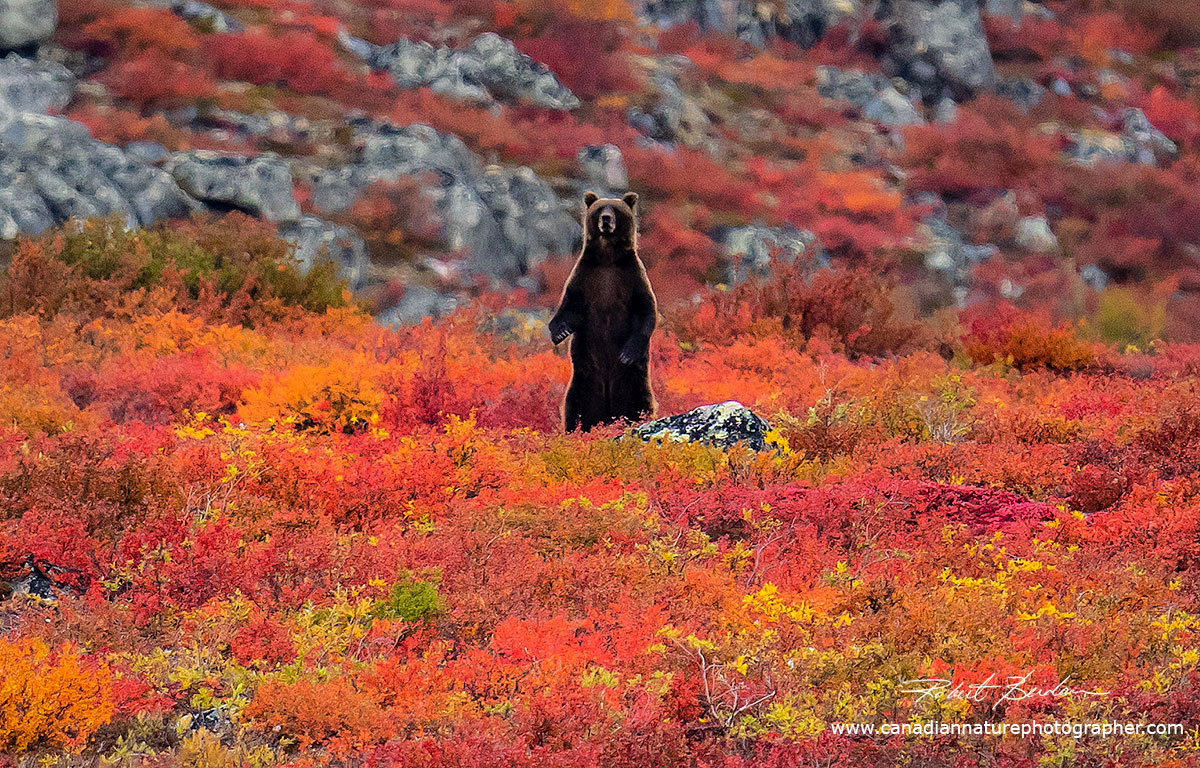
Grizzly standing on the Tundra - 500 mm F4 lens, Nikon D500 taken from a boat.
Each year I lead a photographic tour in conjunction with Peterson's Point lake lodge in Yellowknife and further north at their remote lodge on the Tundra. We spend two days in Yellowknife and then fly 350 Km north on an Air Tindi Twin Otter. Peterson's point lake lodge originally offered fishing and hunting, but now offers primarily fishing and Eco-tourism (photography) tours. Visit the Peterson's Point Lake Lodge web site to learn more about this remote lodge located on the Tundra.

Some of our guests being picked up at the Chateau Nova in Yellowknife
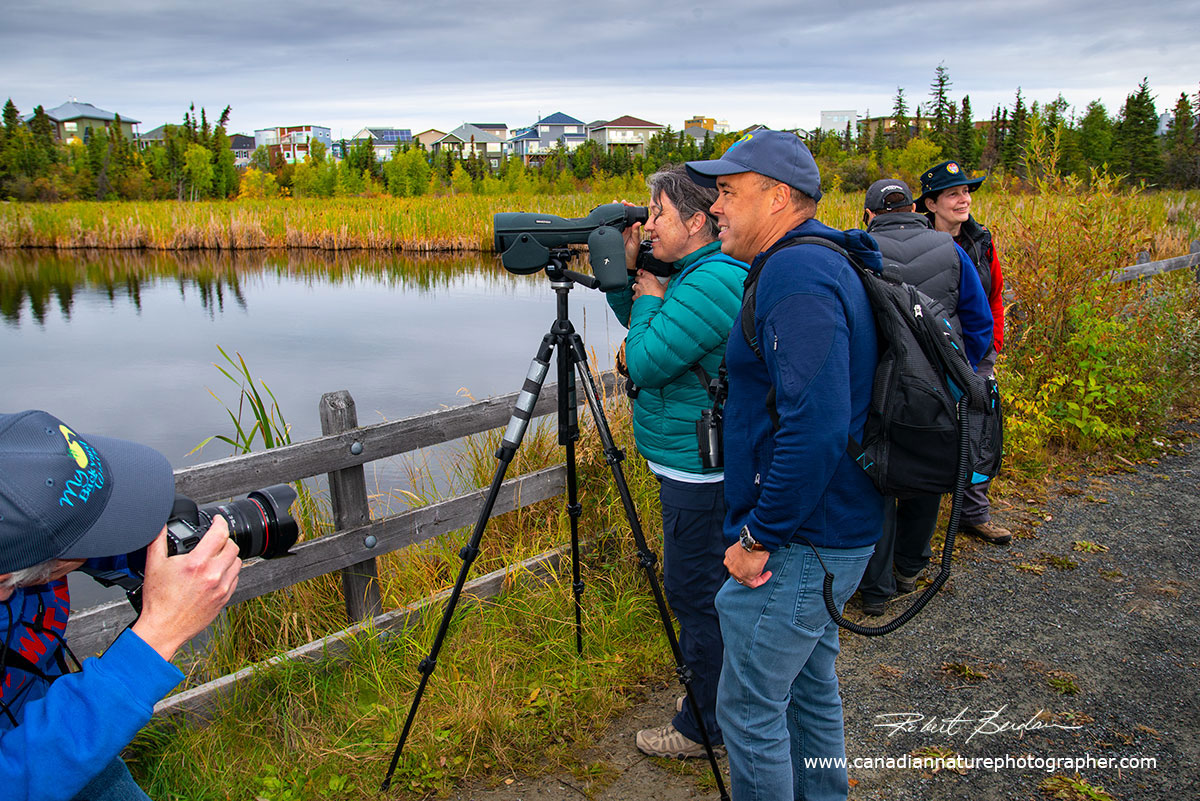
Birding photography in Yellowknife with an expert bird biologist John McKay.

View from Pilot's monument overlooking Yellowknife Bay
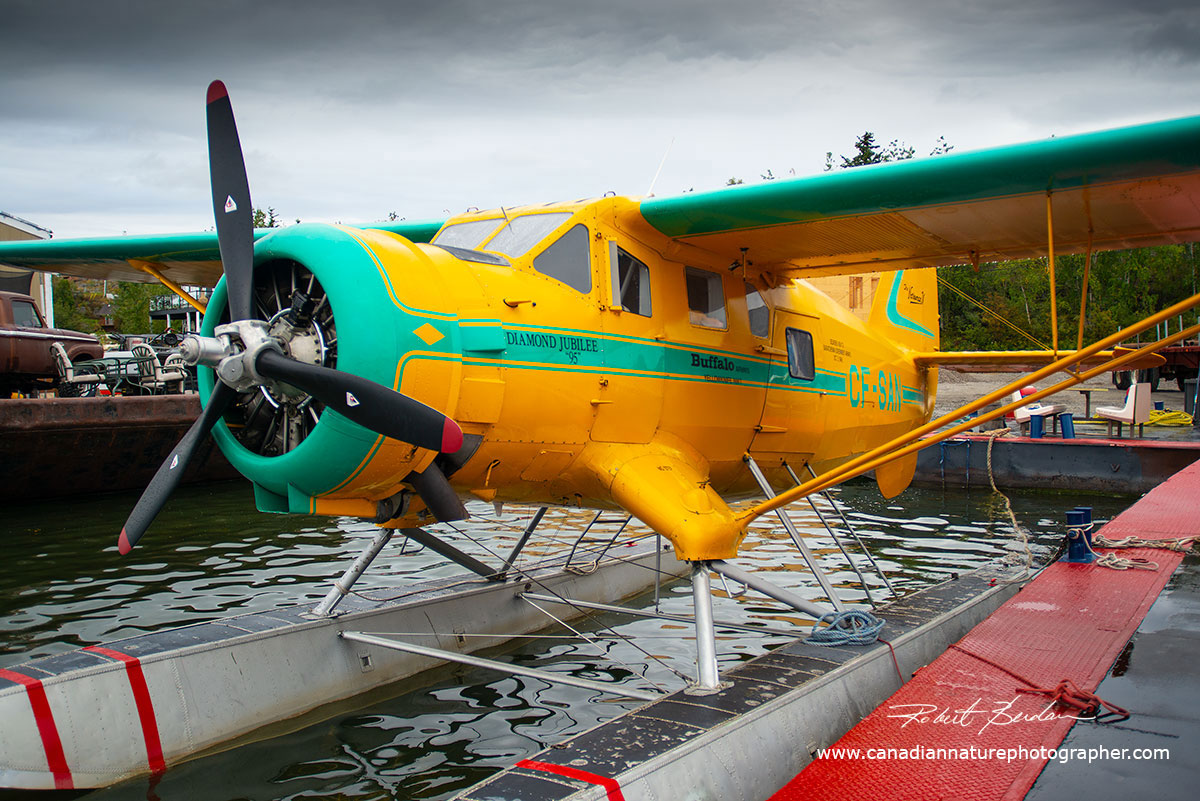
Float plane in Yellowknife harbour

Art board made up of odds and ends on the wall of a home in Old Town Yellowknife

Guests on a boat touring Yellowknife Harbour

Immature bald eagle resting on a rock in Yellowknife Bay, NT
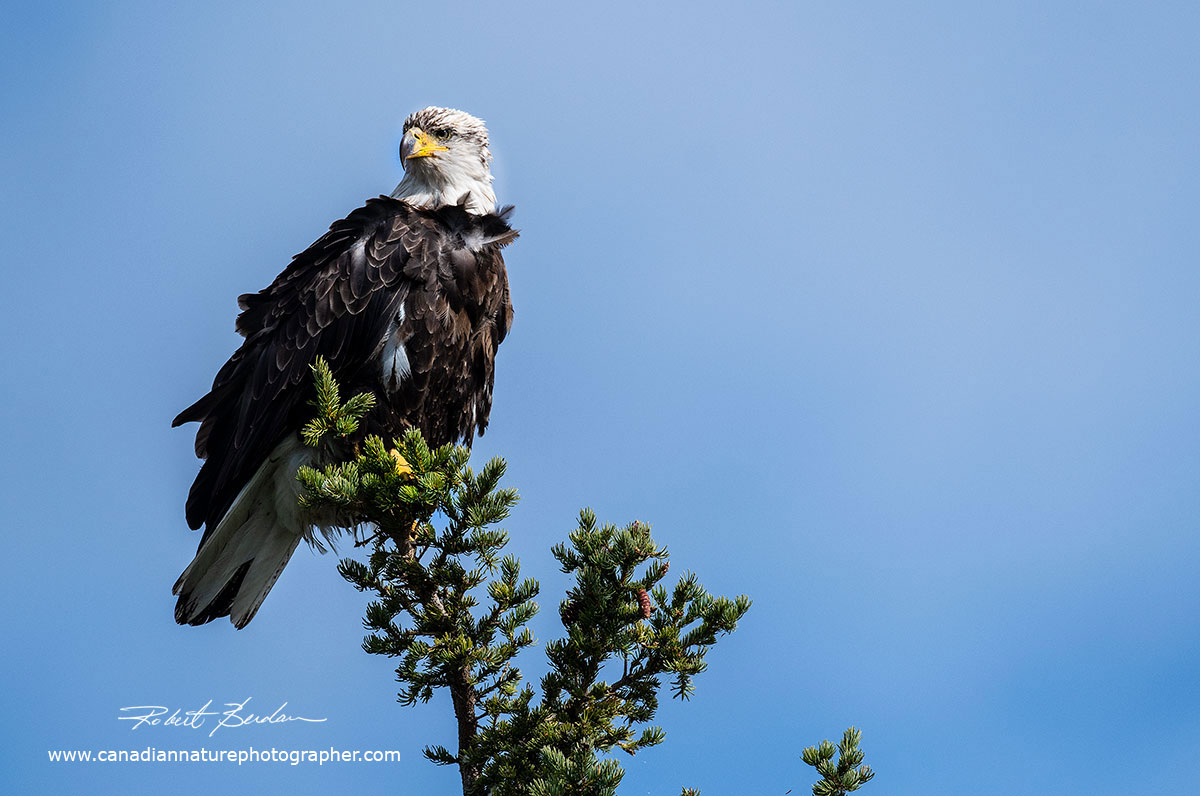
Mature bald eagle in Yellowknife Bay, NT
The photography tour is offered in late summer when the tundra turns shades of orange and red and on clear nights the aurora offers a spectacular display. Potential wildlife at the lodge includes several species of birds e.g. Tundra swans, Peregrine falcons, Gyrfalcon, Canada Geese, American Pipit, Shrike, Harris and white crowned sparrows, eagles, ptarmigan and other migrating birds. Mammals may include barren ground caribou, grizzly bears, wolverine, wolves, moose, arctic ground squirrels (sic sic), voles, weasels and both red and cross foxes. Since wildlife is mobile we can't guarantee specific species. This year was the first time in a decade we did not encounter any caribou near the lodge. We saw evidence of caribou (tracks) and a Norwegian adventurer (Bernie) who we met when arriving at Point lake shared with us some drone video he took several hundred kilometers east of the lodge showing more then 20,000 thousand caribou migrating on the tundra. This year we saw the most barren ground grizzlies I have seen on a single trip (5) and a couple of white wolves.

View of the tundra from the window of our Twin Otter shows thousands of small lakes - photo taken about 150 km north of Yellowknife. The vast size of the tundra is daunting.

Air Tindi Twin Otter landing on Point lake - there is a fresh snowfall on the ground behind the plane.

Twin Otter about to land on Point Lake

Air Tindi Twin Otter Flying over the lodge at Point Lake

View in front of Point Lake Lodge with a caribou skull and antlers in the foreground.

Point lake about a half hour before sunrise

Cladonia sp of Lichen with red sorri. A sorus (pl. sori) is a cluster of sporangia in ferns and fungi.
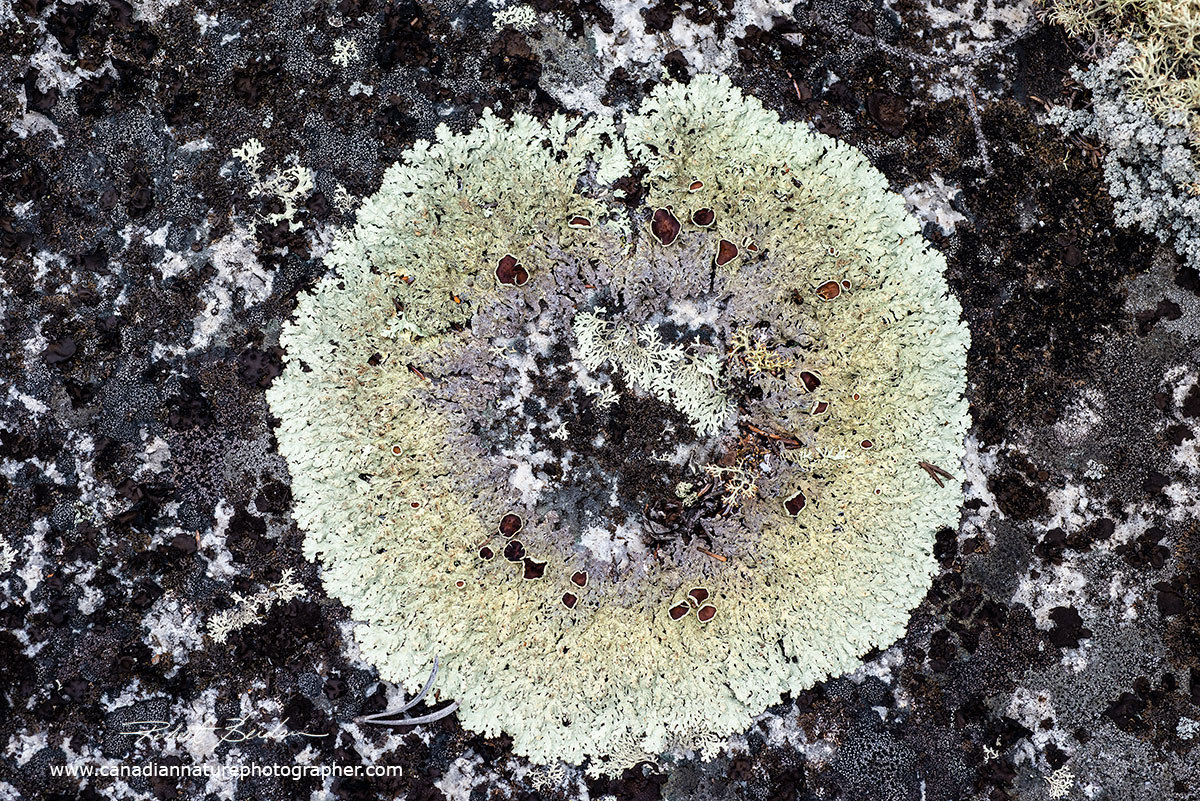
Sunburst lichen with dark sorri. Surrounding the lichen is more lichen of different species - map lichen and black tripe.

The orange lichen is Xanthori sp growing directly on the Canadian Shield Granite. Xanthoria is a genus of lichenized fungi in the family Teloschistaceae. Common names include orange lichen, orange wall lichen, and sunburst lichen. They can be identified by their characteristic Squamulose morphology with distinctive "fairy cups".

Worm lichen - this fruiticose lichen, Thamnolia vermicularis grows on the tundra. It is used by some birds to build or line their nests.
Water Bears (Tardigrades) on the Tundra
This year I collected several samples of Lichen which I brough back in paper bags to Calgary. I put the lichen in distilled water and after day searched for water bears with a stereo microscope capable of up to 50X magnification. Water bears are small animals that live in the film of water in moss and lichens. These animals are hardy and can with stand extreme temperatures, UV, and have even survived in outerspace. So far I found one species of Water bear Milnesium tardigradum (var petersonii). Ok I added the variation name because it was found around Peterson's Point lake lodge in lichen growing on a piece of wood. I have also found this species of water bear living in lichen in my backyard growing on a mountain ash tree. This is a predatory water bear that feeds on other water bears and nematodes (small worms) which were also found in the lichen samples. Not much is known about Tardigrades living in the Canadian arctic or how the effects of global warming might affect them.
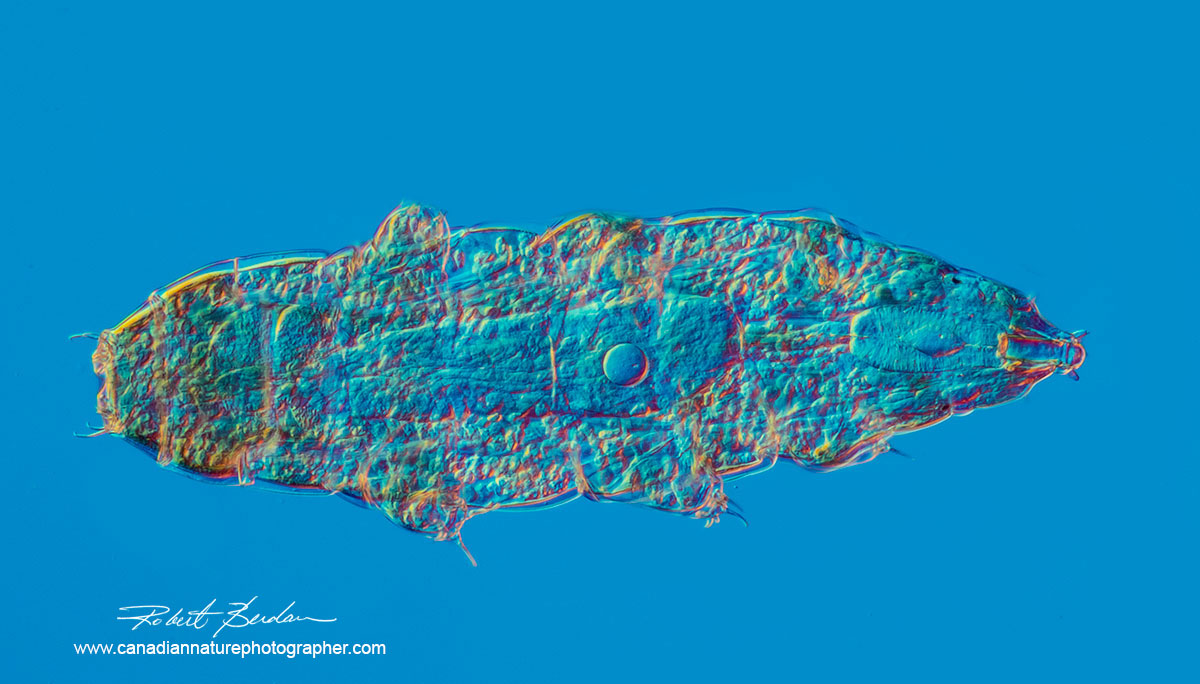
Water bear Milnesium tardigradum - magnified about 100X - the animal is 600 microns long (0.6 mm). Viewed by DIC microscopy.

Water bear Milnesium tardigradum about 150X DIC microscopy. They have two eyes and 8 legs with claws.

Across the Bay from Point Lake lodge are high cliffs that surround parts of the lake.

Tundra near Birthday Point
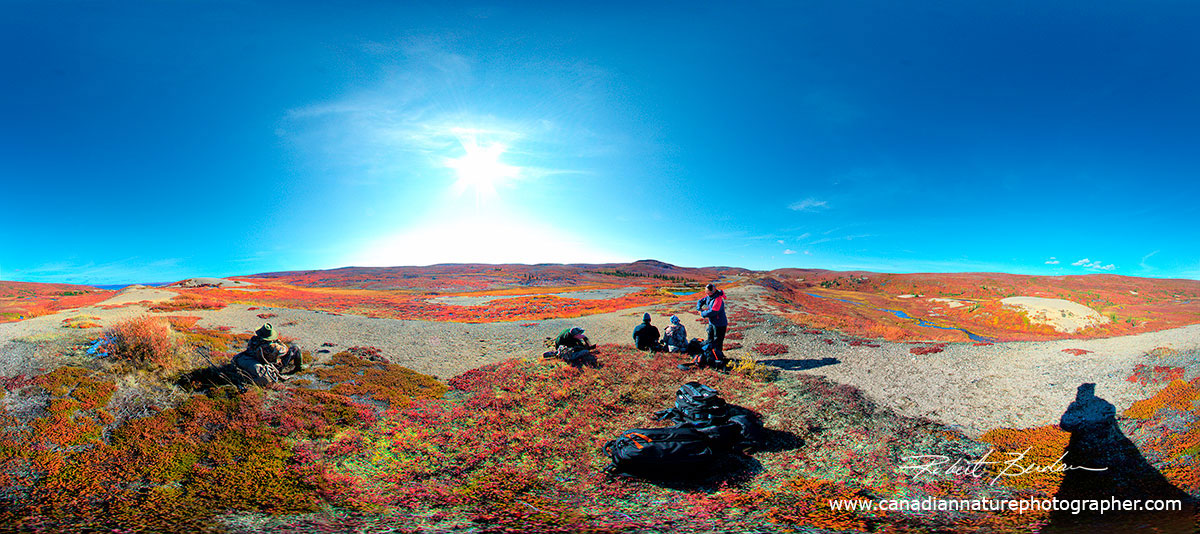
360 degree panorama from on top of an Esker at Esker Bay, Point Lake.
The aurora follows an approximate 11 year cycle whose activity is related to the number of sunspots that send out protons and electrons that excite atoms in earth's upper atmosphere causing them to glow. This year we are at the bottom of the solar cycle though you wouldn't know it based on the aurora we photographed. During peak numbers of sun spots "aurora storms" tend to be more intense and often show more colours: purples, blues, and reds in addition to the green most commonly seen. We had one good night in Yellowknife and one good one at the lodge where I captured most of these pictures.

Aurora at Prelude Lake taken just before the workshop started - the pink colour is characteristic of an active aurora.

Behind Point Lake lodge is a small pond that reflects the aurora - the streak is a shooting star (meteor).

Aurora over pond at Point Lake Lodge, NT
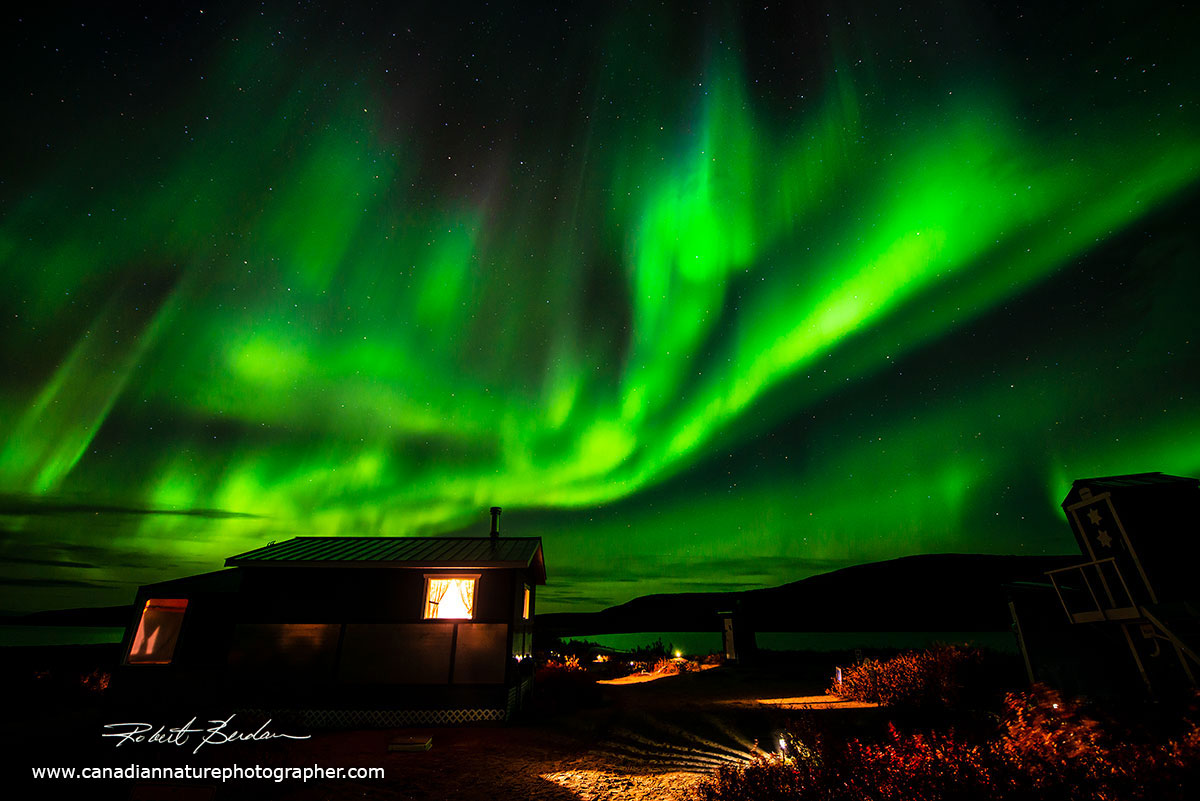
Aurora over the cabins at Point Lake Lodge

Aurora Borealis over the cabins at Point Lake lodge. Note the full moon rising on the left of the photograph. Nikon 14-24 mm F2.8 lens 8 second exposure, ISO 400.

Aurora photographed with Sigma 8 mm Fish eye lens F3.5

Pointing the camera overhead at the corona of the Aurora borealis at Point Lake Lodge.

I used a red light to light-paint the canoes in front of the Aurora in the background
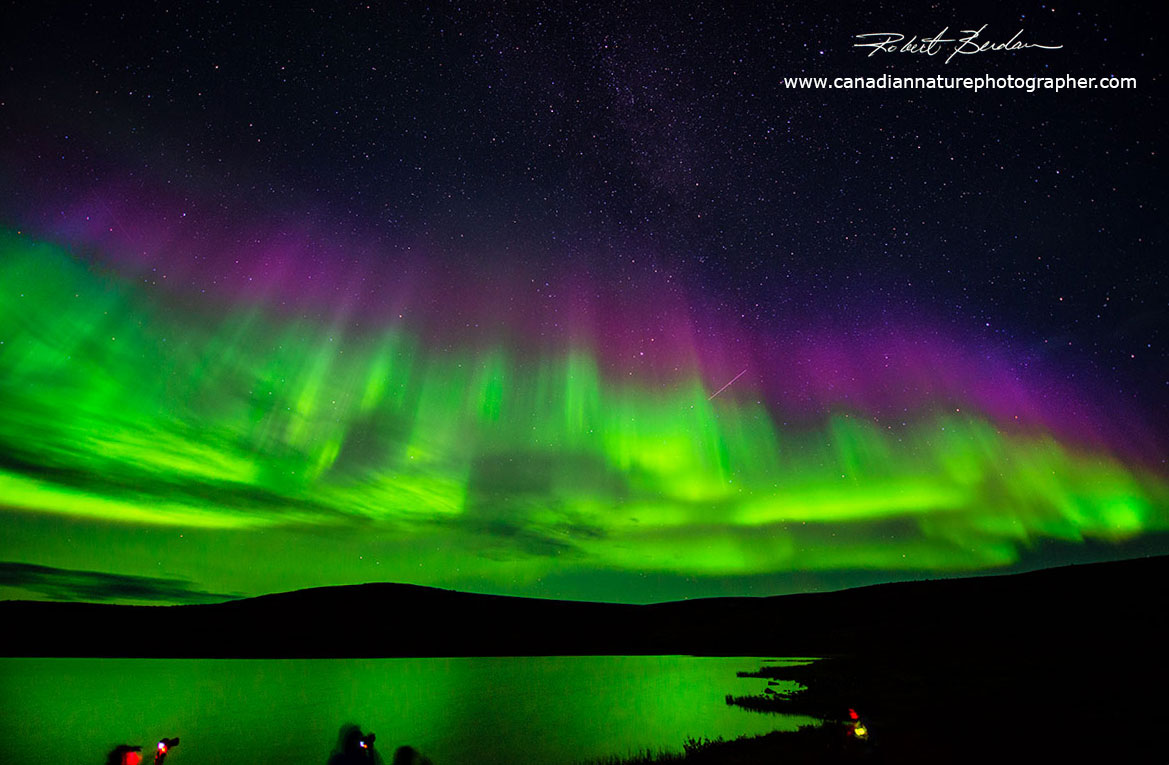
As the Aurora becomes more active there is a hint of purple at the top.
At the lodge we hike and\or travel by boat when the lake is calm and explore the tundra looking for wildlife. The weather can change quickly at Point lake and reach 20°C (68°F) or drop to below zero in early September. This year we had several days of light snowfall and one could feel the cold air blowing across the snow. The snow melted within a day, but it was a reminder that winter was coming. One advantage of a cold night is that it tends to kill most of the black flies which can be a nuisance in the summer.

The first group of photographers heading back to the cabins after a short walk on the tundra

Patrick Pevey and Carol Grenier scan and photograph a small tundra pond
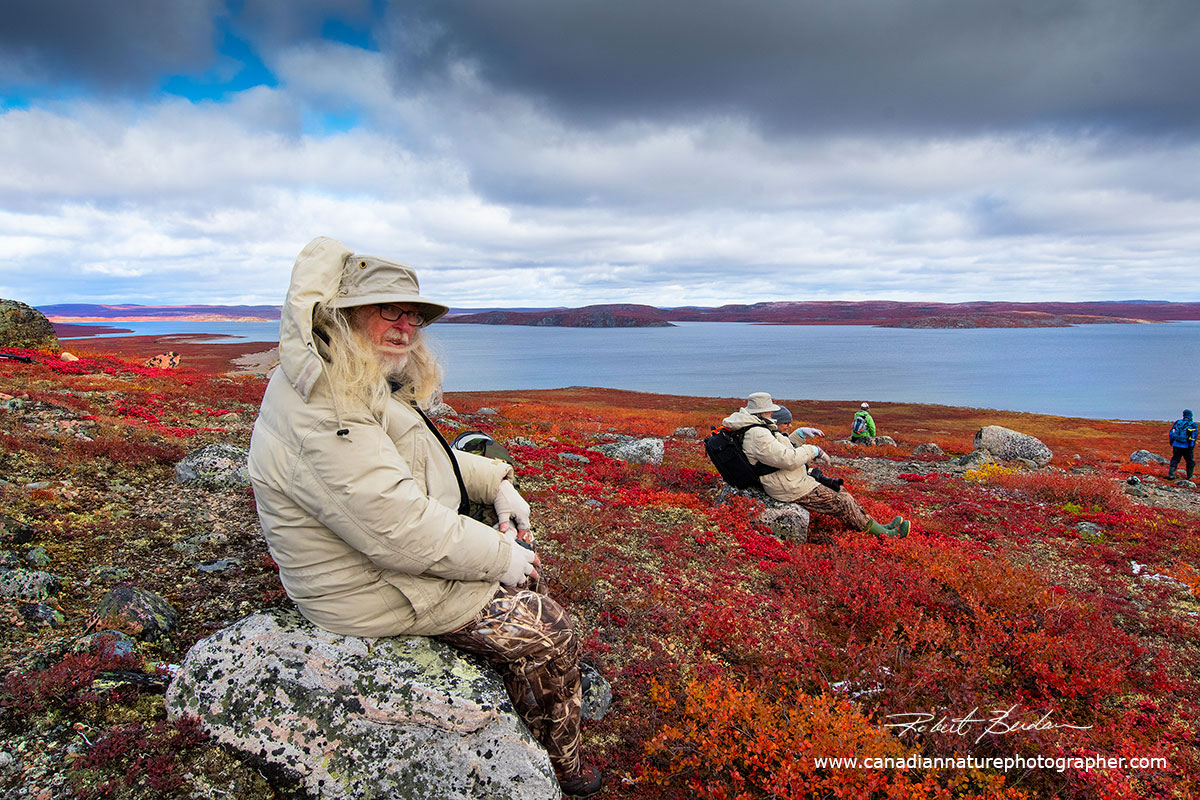
Elston Hill rests on a rock and surveys Point Lake, his wife Jackline is resting on the second rock.

Photographer (Tawna Brown) viewpoint of the tundra - her hat matches the colours on the tundra.
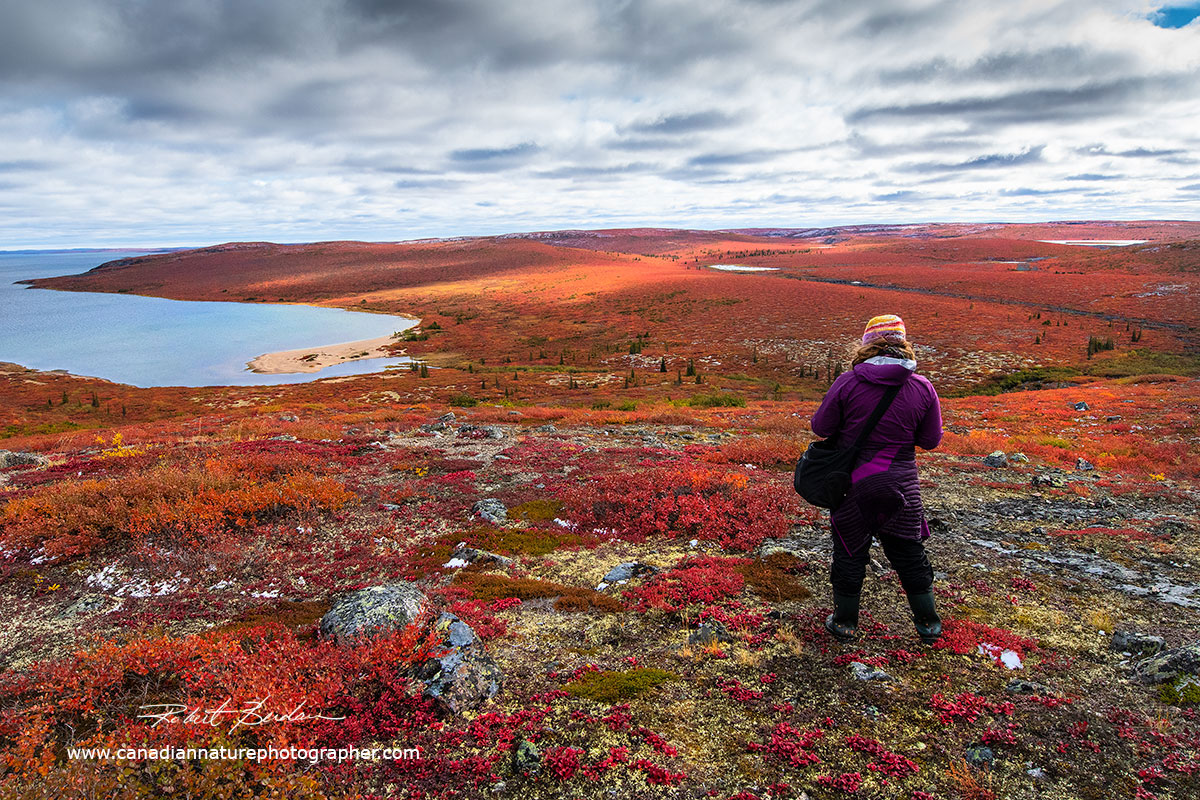
Tawna Brown surveys the tundra and takes some landscape photographs

Grizzly spotted near the shoreline of Point Lake stops briefly to watch us in the boats.

Another grizzly bear surrounded by trees and photographed from the safety of our boats.

Can you see the white wolf?

White wolf heading over the pass. 500 mm F4 lens.

Cheryl Stewart pauses on the Tundra before taking some landscape photographs

Searching for wildlife in a boat near Birthday Point

Searching for wildlife near Birthday Point - travel by boat allows us to survery a lot of space on the tundra while looking for wildlife.

Our second group of photographers pose at Caribou Bay before lunch
This year we had two groups of photographers visit the lodge. Many of the visitors are world travellers and shared some of their beautiful photos from their previous trips and workshops. At point lake we offer 1 guide for every 2 guests. The guides navigate the boats and also bring rifles to protect us if need be from bear encounters. They also spot wildlife and guests can request a guide if they wish to hike outside of camp to photograph. In addition the lodge provides a gourmet cook (Norma) who provides a variety of delicious meals including Turkey, Moose and Caribou and great desserts. I provide nightly presentations on photography and I am available for instruction to those that might need or want assistance during the day.

Guests line up for food at Point Lake Lodge
Our first two days in Yellowknife included a birding tour, a visit to Aurora World for dinner and an opportunity to photograph the Aurora surrounded by tepees. We also offer either a hike to Cameron falls or a boat tour of Yellowknife bay to view the boat houses, birds and experience a fish fry.
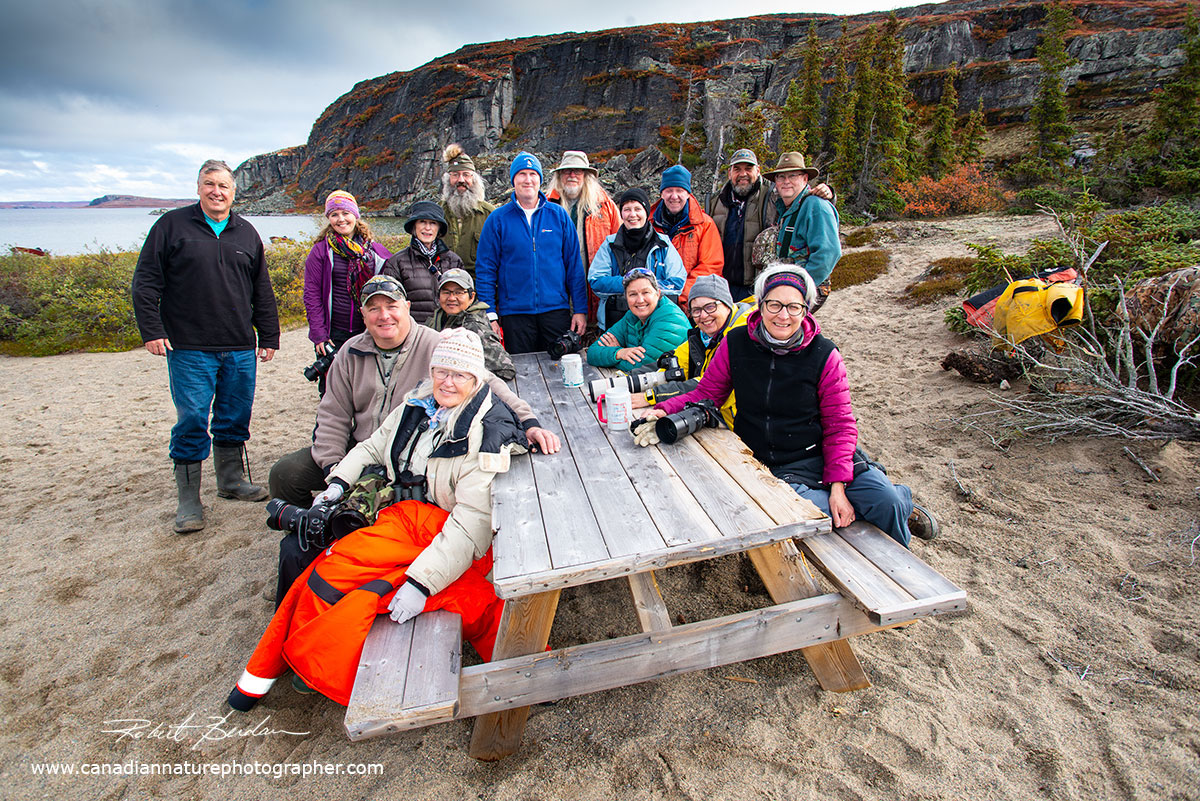
First group of photographers at Outpost 1 - we saw wolf, fox, and caribou tracks. Our Guests included in no particular order: Dale and Lana Connolly from Australia, Diane Boisvert and Jo-Anne Scott from Ottawa, Elston & Jackline Hill (US), Theresa Lende, Joe and Diana Horler (Calgary), and Tawna Brown (Yellowknife). There are also several guides in the picture and myself in black on the left.
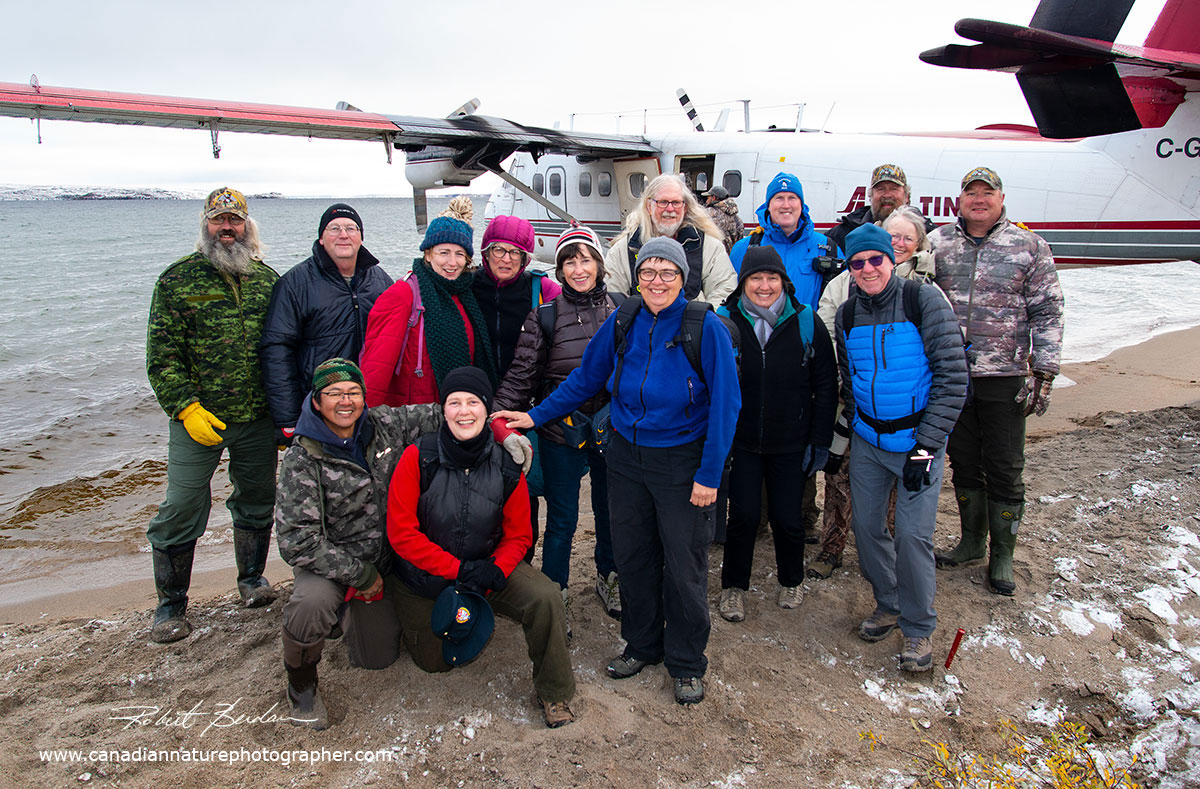
First Group of photographers and guides pose before boarding the Twin Otter for Yellowknife

Lunch time at Carver's Island - Guests include: Chris Clarke, Kathleen McCarthy, Patrick Pevy, Carol Grenier, Marty Welch, Cheryl Stewart, Bill Welch.

Second group of photographers and guides gets ready to head back to Yellowknife.
Yellowknife is a major attraction for tourists, especially those travelling from Asia who seem mostly interested in viewing the aurora. Yellowknife is considered one of the best places in the world to view the aurora. In the past few years Yellowknife has added several new hotels, but if you travel to Yellowknife be sure to book well in advance as most of the hotels seem to be full most of the time. If you are looking for an arctic photographic adventure check out some of the previous articles I have posted and contact the Petersons at www.petersonspointlake.com.
View Roberto Serrini's Drone Video from Peterson's Point Lake 2017. Video 2 Peterson's Point lake Lodge.
Camera Gear to bring to an Arctic Adventure at Point Lake
1. Tripod - essential for aurora photography
2. Fast F2.8 wide angle lens 14-35 mm for landscapes and aurora and a telephoto lens 200 mm+
3. Macro lens for lichen and mushrooms photography
4. Binoculars to spot wildlife
5. Extra batteries, lots of memory storage
6. Warm tuk and gloves, long underwear, flashlight or head lamp with red and white lights
Note: Guests and guides wishing to have a specific image(s) from this article at higher resolution (9x6 in 300 dpi) should email me rberdan@scienceandart.org and let me know which ones you would like.
Links to previous Arctic Adventures Articles
Arctic Adventure 2017
Arctic Adventure 2015
Arctic Adventure 2014
Arctic Adventure 2013
Arctic Adventure 2012
Arctic Adventure 2011
Arctic Adventure 2010
Virtual Tour of the Northwest Territories
What to bring to an Arctic Adventure Workshop
Aurora Borealis Gallery Showing my Favourite Pictures
For information about our Arctic Adventure Workshop see my Workshop page
Acknowledgements: I would like to thank Margaret, Amanda and Chad Peterson for organizing the workshop and taking care of the details. Also I would like to thank all the guides (Egan, Chuck, Bruce, Chad, John and Anthony) for protecting us on the tundra, operating the boats and spotting wildlife. Norma for cooking fantastic meals and Murray for allowing us to photograph the aurora at his place near Yellowknife. Also thanks to our guests who made this trip possible. Finally I thank Bruce Davidson at Prelude Territorial Park who always makes me and my wife feel welcome when camping.
Authors Biography & Contact Information

Robert Berdan is a professional nature photographer living in Calgary, AB specializing in nature, wildlife and science photography. Robert retired from Cell\Neurobiology research to take up photography full time years ago. Robert offers photo guiding and private instruction in all aspects of nature photography and Adobe Photoshop training - including photomicrography, macrophotography.
Email at: rberdan@scienceandart.org
Web site: www.canadiannaturephotographer.com
Phone: MST 9am -7 pm (403) 247-2457.
Click on the buttons below and share this site with your friends